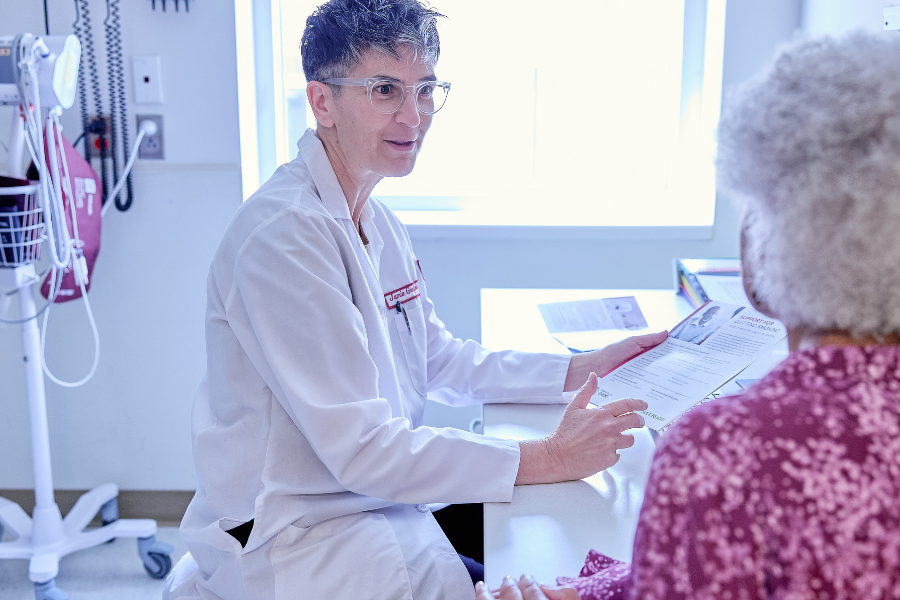Physicians often prescribe pulmonary rehabilitation for patients with lung conditions. This care is designed to improve the quality of life for those living with diseases such as chronic obstructive pulmonary disease (COPD), asthma, or cystic fibrosis. However, there are many misconceptions about pulmonary rehab. Here’s the truth behind some common myths I often hear.
Myth No. 1: Pulmonary rehab is the same as physical therapy.
Fact: Physical therapy addresses injury to a particular body part. Pulmonary rehab uses a comprehensive approach to maximize lung and cardiovascular function.
A lot of patients I work with have never heard of pulmonary rehab before coming to the Temple Lung Center, so physical therapy is their only point of reference. There is some overlap between the two — like strength training. But there are important differences.
When you begin pulmonary rehab, we assess your needs and then design a program of cardiovascular activity and strength training that’s tailored to you. We’ll focus on building strength and stamina with expert support and supervision — and we’ll teach you how to monitor your symptoms so you can take charge of your pulmonary condition. The end goal is to empower our patients to live their best lives.
A high-quality pulmonary rehab program has a multi-disciplinary approach. At the Temple Lung Center, we see you as a whole person, not just a pulmonary rehab patient. For instance, if you are interested in a smoking-cessation program or could use guidance from a nutritionist, the exercise physiologists in pulmonary rehab will connect you to additional specialists at Temple.
Myth No. 2: If you get out of breath, you shouldn’t exercise.
Fact: Even small amounts of movement can improve lung function and reduce shortness of breath.
When patients have trouble breathing, they often move less. That reduced activity leads to weaker muscles and general deconditioning, which tends to negatively impact a person’s quality of life. It can be a vicious cycle — and pulmonary rehab can help turn things around.
There are few things scarier than not being able to breathe. But exercise can help patients breathe better and grow physically stronger. I teach patients to feel confident about their abilities. For the first few weeks, a person may only be able to do a few minutes of exercise. We use an incremental approach to help build stamina over time and to do things they once thought were out of reach, such as walk around a block in their neighborhood or climb some steps in their home. A key step is monitoring vital signs and oxygen levels — and teaching patients how to monitor their condition and safely push themselves to move more.
Teaching patients to manage their condition is an important element of pulmonary rehab. We work with our patients to make sure they understand their program and how it helps them reach their goals. When the program is complete, we make sure they have all the information they need to safely maintain their new lifestyle.
Myth No. 3: People with lung disease can’t improve their health.
Fact: Movement can help most people enhance their overall health.
We work with people who have a wide range of lung conditions, including conditions like emphysema and idiopathic pulmonary fibrosis (IPF). These conditions can’t be reversed. But pulmonary rehab can help patients improve their quality of life and perhaps even keep the disease from progressing.
That’s why exercise physiologists at the Temple Lung Center take the time to explain the benefits of each step of the program. We also teach patients breathing techniques, such as pursed lip breathing, to make the most of their lung capacity.
Pulmonary rehab can also help with another powerful factor for a better life — mindset. Patients learn to focus on making the most of factors they can control, such as exercise, diet changes, and taking medications as prescribed. They have a supportive team as they work toward their goals and gain confidence in their abilities. Pulmonary rehab at Temple is also a time to discuss other concerns, such as safe travel, a return to work and social life, and how supplemental oxygen — if a patient needs it — affects intimacy.
Myth No. 4: Only aerobic exercise helps people with lung conditions.
Fact: Aerobic and strength training both boost quality of life for patients with lung disease.
Some patients who come to pulmonary rehab haven’t focused on strength training before. They see our strength stations and tell me, “I’m not at the gym — what is this?” Others may not be familiar with our bikes, treadmills, or skiing machines.
But at Temple, we use both aerobic exercise and strength training to help our patients meet their goals. Aerobic exercise can build and maintain lung capacity and cardiovascular health. Stronger muscles are more efficient and do a better job of getting oxygen into the bloodstream. Building strength can help with activities of daily life, such as emptying the dishwasher or walking down the hall.
Getting started with weight training can be scary. But consistency is key. I tell patients that we can start with the lightest weight, and we’re just going to keep lifting that weight. And it’s going to get easier, and they’re going to get stronger. Strength training helps body mechanics, joints, and all our moving parts.
Myth #5: If I sign up for pulmonary rehab, I’ll have to keep going forever.
Fact: Programs vary, but most people come to pulmonary rehab for 24 sessions over 12 weeks.
Just as Temple designs exercises for each individual, the length of a pulmonary rehab program is personalized, too. Sometimes, a person who has already gone through our program comes back for additional rehab after a change in their condition.
Patients who need or who have had a lung transplant are typically in our program for an extended period. While they’re waiting for a lung, they need to stay active — this preparation can help make the transplant successful. After transplant surgery, we help people become accustomed to their new normal.
A key component to any rehab program is helping people develop a plan to stay active once their official treatment is done. We provide a specific, detailed program to take the guesswork out of your routine. And we work with you to figure out what kind of plan — such as joining a gym or starting a walking program — will help you continue to thrive.
Pulmonary Rehab Can Help Improve Your Life
Pulmonary rehab can help you make real changes. I love seeing patients gain mobility and confidence as they do something they weren’t able to do before. Some people use wheelchairs and oxygen to get to their first sessions, but by the end of their program, they walk in and out by themselves. If you or a loved one could benefit from this empowering care, please reach out.
Talk to your physician about pulmonary rehab, or call 800-TEMPLE-MED (800-836-7536) to learn more. You can also request an appointment online.
Helpful Resources
Looking for more information?

